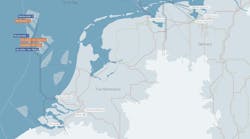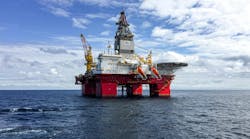Robert Spong
Dan Gallagher
Matt Ferrell
Energo Engineering
The continued design and installation of floating offshore structures intended for 20 or more years of service, combined with the industry trend to extend operations beyond the original design life, provides a challenge for an operators' structural integrity management (SIM) program.
A well-planned SIM program is key to managing structural risks and can greatly reduce unplanned, undesired, and costly in-situ structural repairs and upgrades. This is particularly important for floating production and storage and offloading (FPSO) units because of the added complexities and consequences related to the oil storage and offloading.
The goal here is to discuss the key features of a robust SIM program with a focus on the hull, mooring, and marine systems. An important part of this discussion will be to highlight the key decisions and challenges operators often face maintaining the fitness of these floating structures. The discussion is based on the authors' experiences supporting operators worldwide as they develop, manage, and execute offshore fleet SIM programs.
Developing an SIM program
The best SIM programs begin early in the design process during concept selection. At this phase, where alternative floating concepts are being evaluated, the management of the hull, mooring, and marine system structural integrity should be included as part of the decision criteria when selecting a floating structure. Although the SIM aspects will be conceptual since the details of the structure are not well defined, introducing them early ensures awareness and highlights the influence these decisions will have on long-term operation and maintenance. Additionally, for floating concepts that are novel (i.e., limited experience base) or will operate in remote regions where there is limited support infrastructure, resource availability or knowledge base, the long-term SIM and associated operating expenditures can have an influence when comparing concepts. Early engagement of operations and/or regional business unit personnel with experience maintaining the structural integrity of offshore floating structures ensures SIM aspects are adequately addressed.
Once the final concept has been selected, the design basis should be developed to clearly define the scope, objectives, and performance standards of the SIM strategy. The goals of the SIM strategy are threefold:
- 1. Ensure the benefits of design enhancements that provide improved long-term integrity (e.g., redundancy) or help facilitate SIM activities (e.g., permanent access to key locations) are assessed
- 2. Ensure the required SIM activities such as inspection, maintenance, monitoring or sparing are identified and incorporated in the floating structure SIM plan developed
- 3. Ensure that expected SIM activities including routine inspection, monitoring, and repairs as well as major planned SIM projects (usually focused on renewing corrosion mitigation systems) are identified to provide reliable operating expense (opex) forecasts for the asset.
Similar to the concept select stage, it is important to have the SIM strategy vetted by operations and/or the regional business unit personnel. This will ensure lessons learned are included within the strategy, improving the chances that the program will be effective and executable by operations.
For goal 1, design enhancements to improve the long-term integrity can come in various forms. The benefits of each enhancement will vary between different types of floating structures, driven by specific service requirements and features. Two examples are provided below describing potential FPSO internal tank design enhancements worth considering during design.
One example is the need for permanent internal access to important inspection locations. Strategically placed permanent access can significantly influence the amount of time required to conduct structural inspections, since it will reduce rope access team (RAT) rigging or scaffolding. Newbuild FPSOs will typically follow the latest International Association of Classification Societies (IACS) access requirements which call for permanent access to many important structural inspection locations. However, converted FPSOs, as well as many other floating structures such as tension leg platforms, semisubmersibles and spars do not have this extent of permanent access. In addition, rope access rigging points can be added at convenient locations to reduce time and rigging effort required for inspections. This is especially important in tanks with little or no internal structure.
Another example is seen in the need to provide functional redundancy for all FPSO tank types, especially slops, reception and off-spec tanks. Functional redundancy means that when one key tank is out of service for inspection or more importantly a repair (which can be months in duration), there is a back-up tank designed with the capability to handle the required service on at least a temporary basis without interrupting production. There are a number of examples where operators end up in a never-ending repair cycle because one key tank, such as a dedicated reception tank, is taken out of service for repairs. The duration of completing the repairs can be 12-18 months since the repairs are being conducted in-situ. During this time, the operator uses another tank not designed for the severe service of a reception tank (e.g., high temperature, large amount of produced water, etc.) which results in damage to that tank, which now must also be repaired and the cycle continues.
Also, given the recent industry experience (or current trends), operators should consider possible life extensions when making decisions regarding structural design variables. Designing the structural system based on only the downside predictions of the offshore development often results in significant in-situ refurbishments or in some cases complete replacement of the floating structure to extend the life of the facility.
For goal 2, the structure inspection plan generally defines the primary methods of confirming the structure is fit for service. Inspection plans can be developed in either a generic rule-based manner or using risk-based techniques. For managing the integrity of large floating structures, risk-based inspection (RBI) methods provide significant advantages.
The RBI method enables significant tailoring of the structural inspections and other integrity activities such as monitoring and maintenance around the specific features of the floating structure based on risk. Unlike the more "one-size-fits-all" rule-based approach that has been extended to the offshore industry from the shipping industry, the RBI approach enables a more targeted program that better accounts for the specific facility variables, such as tank service conditions, which are important when dealing with unique offshore structures.
The cornerstone of the RBI method is the risk assessment workshop which is organized similar to a hazard identification (HAZID) workshop used to assess the risks of process systems. Some key benefits of assessing the structure in this manner are outlined below.
Systematic review of the floating structural and marine systems. Generally, the structural system, for example a hull, is broken down into common groups of tanks/areas/components that can be considered together based on service, loads, detail, etc. The process of breaking down and reviewing the structure, focusing on potential degradation mechanisms, design margins and safeguards, provides insight into the structure's susceptibility to degradation, and when this may begin to manifest or impact structural performance.
The results of the risk workshop form the primary basis of the RBI plan and draw heavily upon historical performance experience of similar structures in addition to structural analysis results. The process identifies areas or components of greatest risks and the associated risk drivers. The risk drivers may relate to the consequences, such as deterioration of a primary load path member which could result in significant reduction in global strength. Or, they may relate to the likelihood that non-standard details leave insufficient data to confirm the accuracy of analysis assumptions underpinning strength and fatigue. This risk assessment workshop provides the basis for determining which potential damage scenarios pose the greatest risk, and also for identifying where inspections will be most valuable (i.e. those where risk levels are most reduced by the application of proper inspections).
Workshop forum for operations and design. In addition to the benefits of the formal risk ranking activities, the process of gathering both operations personnel and the project designers into one room will bring out informational "nuggets" based on each person's experience with this or other similar floating structures that would not appear in a project report or other documentation. These groups provide tremendous insights into critical structural details, operational issues that may be a concern, feasibility and utility of various inspections, and hidden issues known only to those intimately involved in the design, fabrication and operation of the floating facility.
Risk awareness of structure performance. Typically, by the end of the workshop there is a consensus on the general outlines of the inspection scopes, frequencies and scheduling. This is done within the inspection plan by clearly documenting the key risk drivers underpinning the choice of inspection scopes and frequencies.
This links the outcomes of the risk assessment workshop with the inspection requirements. The risk results also enable the floating structure inspection activities to be categorized based on risk within a computerized maintenance management system (CMMS). The SIM activities can then be appropriately schedule and budgeted within the entire floating asset integrity management frame work.
Often hulls, moorings, and marine systems are not included in the operator's CMMS as part of the project handover from design to operation. Not having these activities within CMMS results in them being outside the base business activities which have automatic line items in the annual opex budget, as is typically provided to manage process equipment integrity.
For goal 3, the objective is to ensure that the business unit responsible for managing the integrity of the asset understands the expectations of the SIM program and the associated life-cycle costs. This permits the asset owner to adequately plan for SIM activities and allocate the appropriate resources to ensure that they are executed in line with the expectations of the original design basis. Experience has demonstrated that a lack of understanding SIM objectives and requirements can lead to ineffective SIM program execution and ultimately lead to costly integrity failures.
Executing an SIM program
Regardless of what type of inspection plan the operator puts in place, whether purely rule-based or risk-based, the best plan will remain ineffective unless it is actively pursued as part of a holistic SIM program that includes inspection, monitoring and the mitigation of anomalous conditions. While inspection and monitoring are typically well defined by the inspection plan, anomaly mitigation is necessarily more reactive in nature. It requires a robust organization in place to critically assess inspection and monitoring results, identify anomalous conditions, develop mitigation strategies, and execute them.
While it is not possible to predict precisely what mitigations (i.e., maintenance if addressed in a timely manner or repairs if allowed to escalate) will be required each year, experience indicates that there are typically minor activities that can be expected on an annual basis and certain major activities that will be required one or more times during the life of an asset.
The most common annual activities will center on coating touch-ups so that it is advisable to keep a small paint crew available to continuously address initial coating breakdown as it is found. This is especially true for hull tanks during planned inspections where it may be five years before there is another planned opportunity to enter the space. Annual activities may also include anode replacement, equipment maintenance, chemical replenishments, and many other low-level activities.
In addition to normal annual maintenance, there will almost certainly be major renewals required at larger intervals to maintain the asset's condition in alignment with the original design basis. Two of the most common items in this category are tank coatings and mooring lines. There are as of yet no economical 25-year coating systems, and by year 15 at the latest it should be expected that some hull tanks will need coating renewals to avoid prolonged structural exposure to corrosive conditions.
Moorings have in some cases proven to have lives significantly less than originally predicted by standard design practice, and it is now reasonable to expect that at least some mooring lines will need to be replaced during the floating structure's life. Other major renewals may be required based on the floating structure's type and environment.
While the costs of SIM activities are not inconsequential, they are reasonably well understood within the industry and can be incorporated into early stage opex planning. As long as the SIM program is fully executed in accordance with a well-developed SIM plan, it is reasonable to expect that there should not be any significant unforeseen structural failures (i.e. major unplanned opex impacts).
To achieve this, it is critical that adequate resources be made available for SIM activities throughout the facility's life, and therein lies the struggle. In many cases, SIM for hulls, moorings, and marine systems is not treated as a base business activity with an automatic line item in the annual opex budget, as is typical for process equipment integrity. Instead, SIM is treated as a standalone project each year with a requirement to annually justify the level of funding and wait for approvals.
This means that SIM activities must compete annually with other proposed projects for a share of a finite opex project budget. The difficulty is that production-enhancing projects tend to be far more visible and the benefits more readily perceived while, by comparison, floating structures are often not as well understood by the operations group. Due to the limited number of floaters in the industry, most of the available experience is either onshore or on fixed platforms offshore.
In addition, because there is a common perception that floating structures generally degrade slowly and that the inherent redundancy will lead to low-consequence initial failures, a false sense of security is created.
The net result is a tendency for SIM for the hull, moorings and marine systems to lose out when budgets get tight or there are other resource constraints on the facility. This struggle only becomes more acute with an aging facility where SIM requirements grow and production levels decline.
When resources are not allocated to SIM as required, the program as well as the facility suffers and there will be gaps in the program execution. Examples typically include a combination of the following:
- Inspections may not be executed as planned in terms of timing or extent
- Some scope may be omitted to avoid higher cost inspections (e.g. rope access inspections, NDE, divers, ROVs, etc.)
- Results may be shelved and not adequately reviewed to find anomalous indications
- Anomaly mitigation strategies may not be implemented or are delayed until the situation is critical.
When these gaps begin to appear, coating failures, corrosion, local buckling and cracks can be missed, increasing the risk that they will escalate to higher consequence failures when the damage is finally addressed. This can lead to significant safety or environmental consequences, damage to the owner's reputation as well as the need for immediate, unplanned repairs.
Unplanned repairs can have many negative impacts on a facility. There may be significant financial implications as the funding will likely be extra-budgetary and there may be a need for specialized equipment and expertise required in an expedited manner. In addition, there can be significant operational impacts from extended storage unavailability (FPSOs) and offloading issues all the way up to complete production shut-in. One significant unplanned repair as a result of neglect can easily overcome any potential savings from minimizing SIM activities.
Recognizing the value propositions at stake, industry leading operators are now taking SIM very seriously on their floating assets and are allocating significant resources to these programs. They have come to understand that using SIM as a place to trim budgets is a false economy. The choice is essentially "pay now or pay more later," with the former constituting a robust SIM program carried out in a planned and predictable manner with a known risk profile; and the latter coming in the form of a higher (or worse, unknown) risk of serious safety and environmental consequences, costly unplanned repairs, and significant operational impacts.
Prudent operators include SIM programs as part of base business budgets and require that SIM activities (inspection, monitoring, and anomaly mitigation) for hulls, moorings, and marine systems be captured in the CMMS.
In addition, they routinely reconsider and update the overall SIM program as necessary (on at least a five-year basis) to ensure that the planned SIM activities continue to be suited to the current floating structure condition and life expectancy. Experience has proven that a robust SIM program is a key element to maintaining a fit-for-service floating structure that meets operators' long-term performance objectives.
Offshore Articles Archives
View Oil and Gas Articles on PennEnergy.com




